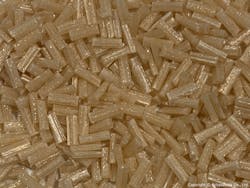Polyplastics targets sustainability with cellulose-reinforced PP
Plastron LFT The thermoplastic resins in Polyplastics’ Plastron LFT line are reinforced with glass and carbon fibers that are the same length and orientation in each pellet. The PP and polyamide resins are characterized by greater rigidity and higher impact strength than conventional fiber-reinforced resins.
What’s new? Eco-friendly cellulose reinforcement. Polyplastics now is offering Plastron LFT PP grades reinforced with specially formulated cellulose fibers. Insufficient strength has been a limiting factor for natural cellulose fibers, the company said. Polyplastics has developed a patented method of making regenerated cellulose — cellulose that has been converted into continuous fibers via wet spinning, a simple, low-waste process that emits very little carbon dioxide. The new resins are appropriate for replacing short-fiber glass-reinforced PP resins or long-fiber glass-reinforced resins.
Benefits Lighter weight, greater strength and sustainability. Long-fiber cellulose-reinforced PP resins have a lower density than PP reinforced with long glass fibers and higher values for Charpy impact strength, tensile strength and flexural strength, the company said. The resins allow manufacturers to reduce the carbon footprint of their products and meet sustainability goals.
Polyplastics USA Inc., Farmington Hills, Mich., 248-479-8928, www.polyplastics.com
